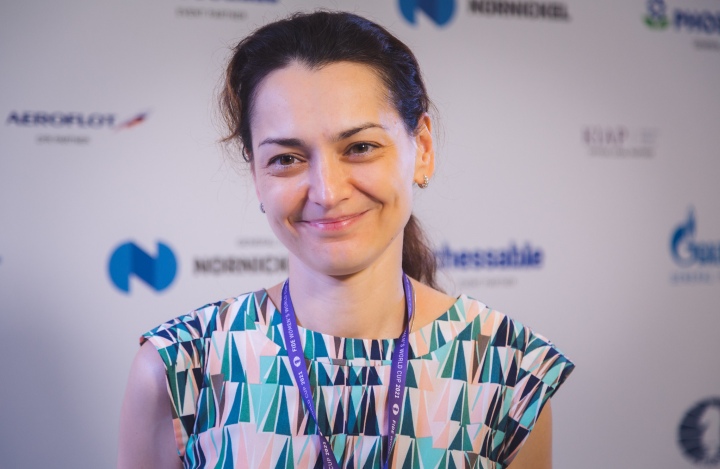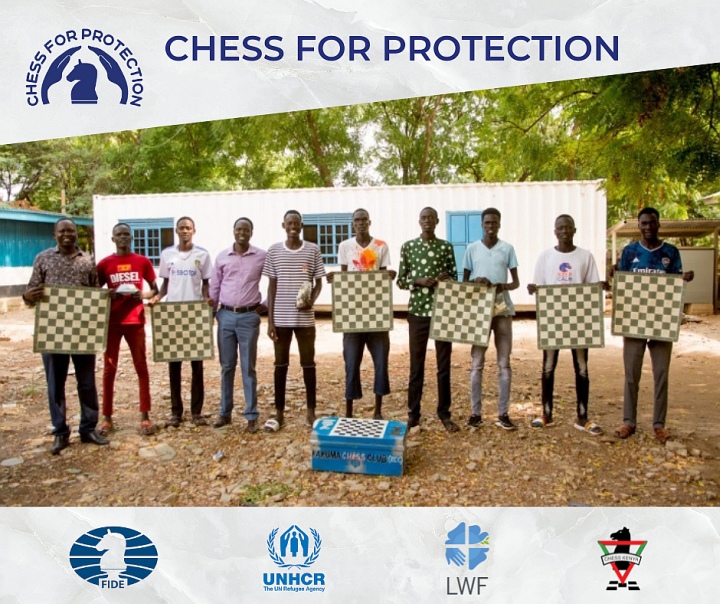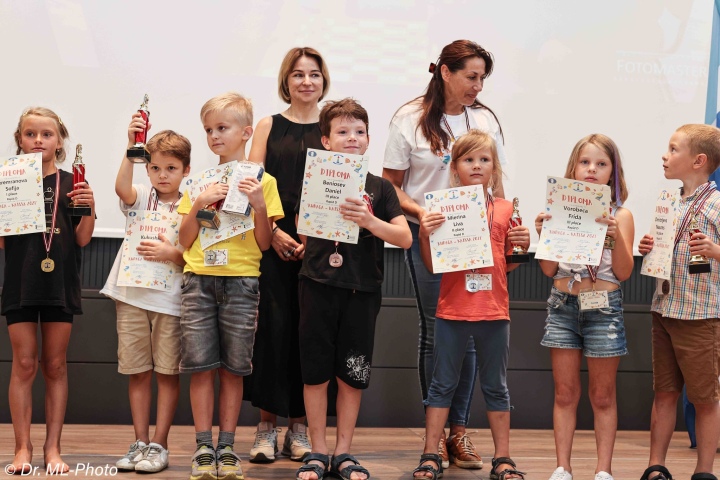Alexandra Kosteniuk, Women’s World Cup Champion!

Sergey Karjakin first finalist: Carlsen and Duda will tie-break tomorrow Monday, August 2nd 2021 – Afternoon’s such as today are a joy for chess fans. Aggressive openings, hard-fought middlegames, great endgame technique and of course amiable companionship. So interesting that FIDE President Arkady Dvorkovich keenly followed the games at the start of the round, before returning to his duties at the important FIDE Council Meeting, which is also being held these days in Sochi. In the first semi-final between GM Jan-Krzysztof Duda (2738) and GM Magnus Carlsen (2847), Poland’s number one opened with 1.e4 and the World Champion went for an open game. Soon the game evolved into one of the many anti-Marshall variations of the Ruy Lopez with 8.a4, which Carlsen had already faced a few days ago in his game against Bacrot. Possibly fearing some dangerous home preparation, Carlsen deviated with the less common 8…Rb8 (instead of 8…Bb7), which Duda was definitely not expecting, as he took nearly ten minutes for his next move. The game spiced up when Carlsen went for 9…d5, going for a Marshall Gambit type of position. Duda picked up the gauntlet and captured the pawn. After 17…g5 it was obvious to everybody that Carlsen had it all worked out: he was playing very fast and Duda was falling behind on the clock. Prudently, Duda decided to exchange queens and the game transitioned into an equal endgame, with an extra pawn for White compensated by Black’s bishop pair and development. Although we were not able to find any games with the actual position, this type of endgame normally ends in a draw. White generally gives back the pawn to keep the balance, or opposite-colored bishop endgames often appear. However, unexpectedly in pure Marshall spirit, Duda sacrificed his rook for a knight and a pawn. With two pawns for the exchange, it was clear that Duda couldn’t be worse but did he have the advantage? Magnus demonstrated that the draw was always there. A hard-fought game, but nevertheless both of them will return tomorrow to battle it out in what will be a very exciting tie-break. In the second semi-final, between Russian top players GM Sergey Karjakin (2757) and GM Vladimir Fedoseev (2696), the opening was also the Ruy Lopez, although in this case, Fedoseev chose the solid Zaitsev variation, quite content with the famous draw by repetition that occurs after 11.Ng5 Rf8 12.Nf3 Re8. However, no one expected Karjakin to back down so early, and therefore 11.Nb-d2 was the main continuation. The turning point in the opening was move thirteen, when Fedoseev chose 13…d5 – played several times by Alexander Morozevich – instead of the main line 13…Nb8. Both players were blitzing out their moves until Fedoseev pushed 19…f5. Karjakin went into the tank and after twenty-five minutes of deep thought came up with the novelty 20.h4, trying to improve on the games between Tari-Vidit (2018) and Oparin-Morazevich (2015). The idea is to control Black’s kingside expansion. This might have taken Fedoseev by surprise, as soon after he blundered with 21…Rf8? allowing White to take the initiative with 24.e6!, which vacates the e5 square for a minor piece. Fedoseev didn’t react in the best way and soon he was under serious pressure, the main threat being f3!, expelling the knight from the center and activating White’s hidden bishop on c2. In desperado mode, Fedoseev initiated a series of exchanges beginning with a knight sacrifice on f2, but Karjakin had it all under control. After 31.d5 it became clear that Karjakin would be playing his second World Cup final: he won the title on Baku in 2015. After the game, Karjakin was kind enough to give us his views on the game and who he prefers in the final: Duda or Carlsen? After yesterday’s defeat, GM Aleksandra Goryachkina (2596) was in a must-win situation. Although she lost with the French Defence against GM Alexandra Kosteniuk (2472) in 2018, she decided to give it a second chance today. Kosteniuk deviated from that previous game with 3.Nd2 and Goryachkina went for 3…c5, her main weapon against the Tarrasch variation. On move nine, Goryachkina tried 9…b6, instead of 9…Nc5, which was her choice against Kashlinskaya in 2019, a game which she went on to win. She had prepared this move having seen an even older game which Kosteniuk played in 2013 against Jovana Rapport in the European Championship. Did Kosteniuk recall the game? Hard to know. One can only speculate on such things. In any case, 12…Rc8 was Goryachkina’s novelty and after a few moves the game was totally unbalanced: Black’s development was decent, but her king would have to stay in the center for the rest of the game. Obviously, this kind of unbalanced middlegame would clearly favour Goryachkina. Kosteniuk had a lot on the line. She prudently decided to play it safe, avoiding unnecessary risks, and timely exchange of queen’s and rook’s nipped Goryachkina’s counterplay in the bud. The endgame was academic: opposite-side coloured bishops and equal pawns. The game was heading to a draw but Goryachkina over-pressed and ended up in a clearly lost queen ending. However, Kosteniuk graciously offered a draw, which her opponent accepted. In the final women’s World Cup interview, a very happy Alexandra Kosteniuk gave us her thoughts on the match and her overall tournament success. In the match for the third and fourth place in the Women’s World Cup, China’s GM Tan Zhongyi (2511) repeated the Petroff Defence and GM Anna Muzychuk (2527), representing Ukraine, went for the unambitious 5.Bd3 side-line. White could have obtained the bishop pair with 12.Nxe7+ but she decided that Black’s development was more than enough compensation. After twenty moves the position was equal and resembled more an exchange French defence than a Petroff. White had the two bishops but Black’s strong knight on e4 was impressive. Slightly worse, Muzychuk offered a move repetition on move twenty-seven with 27.Bd1 and 28.Bc2. However, Tan Zhongyi declined and waited for a better moment to force the simplification. The ending was clearly better for the Chinese player – her minor pieces were clearly better – but Muzychuk defended tenaciously and a draw was agreed on move forty-nine. Tomorrow’s tie-break
FIDE deploys Chess for Protection project for refugees

The International Chess Federation with the support of UNHCR, the UN Refugee Agency, Lutheran World Federation (LWF), Kenya Chess Federation and Kakuma Chess Club has launched a Chess for Protection project, aiming to consolidate and develop chess practice in Kakuma refugee camp and Kalobeyei settlement in Kenya. The name of the project is “Chess for Kakuma and Kalobeyei People”. The project started today, on 2 August, with the online opening ceremony and simultaneous exhibition played between FIDE Managing Director Dana Reizniece-Ozola and members of Kakuma Chess Club. The kick-off event also featured UNHCR Head of Sub-Office Kahin Ismail, UNHCR Kenya Country Representative Fathiaa Abdalla, FIDE President Arkady Dvorkovich, Chess Kenya President Benard Wanjala, FIDE Vice President Anastasia Sorokina and other officials. “Over 55% of the refugee population in Kakuma are children and adolescents. The importance of engaging youth in extra-curriculum activities cannot be overestimated. This initiative will no doubt contribute to the wellbeing of youth, their psychological needs and their development. We are very glad to launch this project with all our partners – FIDE, LWF, Kenya Chess Federation, chess clubs in Kakuma. We are looking forward to nurturing and supporting this very important activity as an additional element in which our youth will partake, and I am sure will excel as we see them do in many other sport and cultural activities,” said Kahin Ismail, UNHCR Head of Sub-Office in Kakuma. “The Chess for Kakuma and Kalobeyei project is an excellent initiative to engage refugee youth in productive and engaging social activities. Chess is becoming increasingly popular among the youth in Kakuma and Kalobeyei. Our young boys and girls, women and men are joining many chess clubs. It will allow youth to bring the solidarity, enthusiasm, inspiration and energy to act as agents of positive change in their communities. I wish to thank FIDE and LWF for providing innovative and productive solutions to address some of the challenges faced by refugee youth in Kakuma and Kalobeyei,” Fathiaa Abdalla, UNHCR Kenya Country Representative emphasized. FIDE President Arkady Dvorkovich: “In FIDE we really believe in inclusive sports and inclusive chess. We are happy that our joint initiative with UNHCR, LWF and Chess Kenya has attracted so much attention. We have to promote chess not just as a sport but as a tool to improve our society, to promote healthy habits and inspire self-improvement and self-growth in many people. A big part of our mission is to promote chess as an instrument to improve the social environment for thousands or millions of people. We have been doing quite a few things already including projects like Chess for Freedom, Chess for Children with Autistic Spectrum Disorder, we ran the Online Olympiad for people with disabilities with 400 people participating. Now we are launching this huge project for refugees. We welcome all of you to our chess family! Yesterday we discussed the possibility of having a team of refugees at the next Chess Olympiad in Moscow. Hopefully, some of you can come to Moscow next year to participate in this event along with 200 other national federations.” LWF representative Julius Arawan: “I’d like to say that I appreciate what was done by FIDE and UNHCR to support youth in Kakuma and engage it in chess activities. We know that playing chess is very important for youth, for developing critical thinking and for future careers. We will continue to work with FIDE and UNHCR to ensure that this activity is realized and youth is involved in it.” Chess Kenya President Benard Wanjala: “I am very happy to be a part of this historic launch of the Chess for Protection project. Kenya has the second biggest refugee camp and the third biggest slum in the world. This creates very uncomfortable living conditions for youth and children who lack resources and opportunities to follow their life dreams. This is not just about chess, it’s about giving dreams to children. Chess Kenya is very proud to be a part of this initiative.” FIDE Managing Director Dana Reizniece-Ozola: “I hope that this project will bring fruits not only to refugees themselves but will also be a great satisfaction for us, the people involved in it. There’s strong evidence that chess structures the brains of people. If they regularly go for it, it increases their analytical skills, self-esteem and the understanding between the cause and the consequence. That is something that is instrumental in the lives of all human beings, but probably particularly in the lives of people in vulnerable situations. We will start with training the youth and kids in approximately 40 schools. In parallel, we will focus on the empowerment of young females and girls. Life skills training program will be carried out in the schools for girls where they will have chances to meet inspirational chess players and ladies representing other professions. They will be sharing their experiences and life stories and giving examples of how to reach success even if your starting point is not the best.” FIDE Vice President and the mastermind of Chess for Protection project Anastasia Sorokina: “I kept an idea of this project for a long time as I believe with all my heart that chess gives a lot of extra opportunities in your life. Chess also gives you extra skills, it teaches you not only how to win, but also how to survive when you lose. All of them are really life skills. That’s why I think this project is especially important for people who lost their homes or are living in new places where they are trying to adopt and live in a new community. Chess makes people united. I shared this idea with FIDE Managing Director Dana Reizniece-Ozola, and I am happy she supported it. I would like to thak all the UNHCR team for their support, we are very happy to work together and to get this project on board.” The official ceremony was followed by a simultaneous exhibition by FIDE Managing Director Dana Reizniece-Ozola for four members of Kakuma Chess Club. One of the
Winners crowned at Rudaga-Kaissa 2021 Festival

The Rudaga-Kaissa 2021 International Festival that brought together over 400 participants came to an end in Jurmala. For the first time, the event was held in the festival format and under the auspices of FIDE. Apart from online and over-the-board tournaments, the festival included masterclasses, meetings, simultaneous exhibitions, and other chess activities. We are happy to announce the winners of the over-the-board tournaments in different categories. Naturally, there were many top-finishers from the host country, but guests from other parts of Europe proved to be very serious competitors. Congratulations to all! Standard Open: 1. Shturman Arseniy (RUS)2. Strods Kristaps Reinis (LAT)3. Tabors Emils (LAT) Standard Girls: 1. Kuznecova Marija (LAT)2. Daineko Jevgenija (LAT)3. Locmele Valerija (LAT) U14 Open: 1. Jaakkola Niklas (FIN)2. Testelecs Ilja (LAT)3. Sokolovskis Pavels (LAT) U14 Girls:1. Maklakova Naomi (LAT)2. Maklakova Dafne (LAT)3. Kirijanova Sintija-Lina (LAT) 10 Boys:1. Jeronovics Toms (LAT)2. Platonovs Nikolajs (LAT)3. Kakurin Artem (RUS) U 10 Girls: 1. Gurevich Alexandra (ENG) 2. Teremranova Sofija (LAT)3. Sirajeva Anna Mira (LAT) The youngest boy and girl in the festival, the best boy and girl in rapid group C (born after 2009) and group D (born after 2013), the best boy and girl in blitz born after 2009, and the best boy and girl in standard chess born after 2009, all received Gold Participant certificates from ChessKid.com. The winners of the standard chess event, Arseniy Shturman (RUS) and Marija Kuznecova (LAT) received the main prize of the festival – accreditation to the 2022 World Chess Olympiad, tickets to the opening ceremony, and accommodation for two nights at the official hotel of the Olympiad. During the closing ceremony, FIDE Vice President Anastasia Sorokina thanked the participants, parents and organizers – public organization “Rudaga plus”, Jurmala City Council, Rudaga Children and Youth School of Education and Creativity (Jurmala, Latvia), KAISSA (Riga, Latvia), Semarah hotel Lielupe. She expressed hope that this festival under the auspices of FIDE will become an annual event. Tournament Director Inessa Testelec thanked FIDE for its support and presented a memorable gift for the FIDE President.

